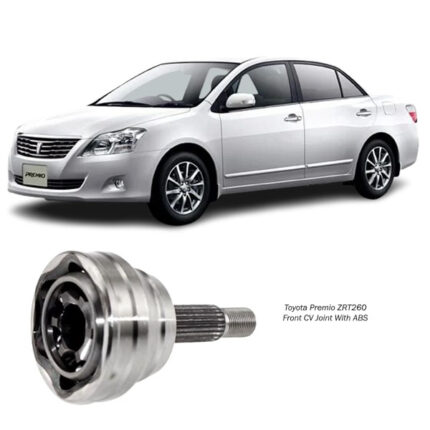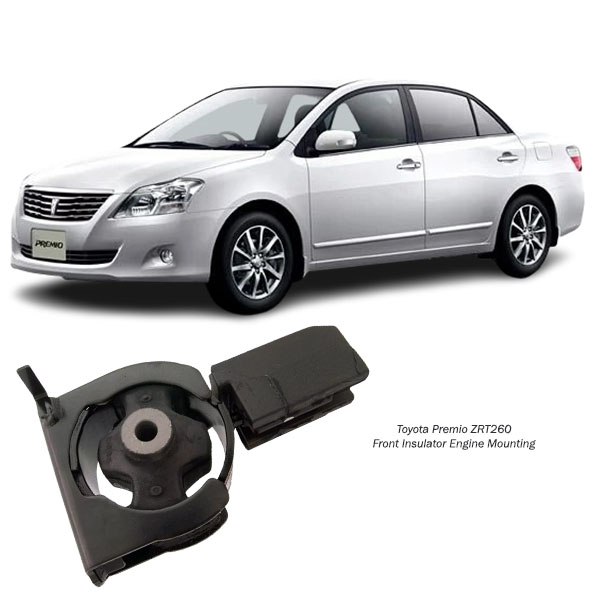-13%
Get Toyota Premio ZRT260 Front Insulator Engine Mounting 12361-37060 in Kenya
When you think of your vehicle’s engine, you probably picture horsepower, pistons, and speed. What you might not think about is how that powerful engine stays firmly in place while running full throttle. That’s where the front insulator engine mounting comes into play—a small yet mighty component that quietly supports the engine and absorbs vibrations to keep your ride smooth and quiet. 🚗💨
Let’s explore what this part is, how it works, why it matters, and what happens when it starts to wear out.
⚙️ What is a Front Insulator Engine Mounting?
The front insulator engine mounting—often simply called the engine mount—is a specially designed component that connects the engine to the vehicle’s frame or chassis. It does more than just “hold the engine”; it absorbs engine vibrations, stabilizes movement, and ensures that the engine doesn’t shift during acceleration, deceleration, or while driving on rough terrain. 🛞
The “front” designation refers to the mount positioned near the front of the engine bay—typically one of several mounts supporting the engine and sometimes the transmission too. In most modern vehicles, you’ll find a combination of front, rear, and side engine mounts.
🧽 What is It Made Of?
A front engine mount is typically constructed from:
-
Heavy-duty rubber or polyurethane: For vibration damping and shock absorption 🧸
-
Steel brackets or housings: For strength and durability 🏋️♀️
-
Hydraulic fluid (in some mounts): To enhance vibration control in newer, more advanced mounts 💧
The rubber insulator is sandwiched between metal plates, allowing it to flex slightly and isolate engine movement from the cabin.
🧩 What Does It Do?
The front insulator engine mounting has several vital roles:
-
Supports Engine Weight ⚖️
It bears a significant portion of the engine’s weight, holding it securely in place. -
Reduces Vibration and Noise 🔇
The mount isolates the vibrations caused by engine combustion and rotation, making the ride smoother and quieter for passengers. -
Prevents Engine Movement ⛓️
During braking, turning, or accelerating, the engine wants to twist or shift. The mount holds it firmly in position. -
Protects Other Components 🛡️
Without proper mounting, engine movement could stress other parts like hoses, exhaust systems, wiring, and the radiator.
🚨 Signs of a Worn or Damaged Front Engine Mount
Like all parts, engine mounts wear out over time. When they begin to fail, the signs may be subtle at first but get more noticeable as the damage progresses.
1. Excessive Engine Vibration 🔊
You may feel more vibration through the steering wheel, floor, or pedals—especially when idling.
2. Clunking or Banging Sounds 🔨
When shifting gears or going over bumps, the engine might shift enough to knock against other components, causing a loud “thud” or “clunk.”
3. Engine Movement 🔁
With the hood open, you might notice the engine visibly shifting or rocking when revving or putting the car in gear.
4. Unusual Handling or Acceleration Feel 🎢
Worn mounts can make the vehicle feel jerky or unstable during acceleration or braking.
5. Cracked or Worn Rubber 🧱
In a visual inspection, you may see that the rubber part of the mount is cracked, brittle, or separated from the metal bracket.
🔧 Why is Replacement So Important?
Driving with a faulty engine mount can lead to bigger issues. Here’s why replacing it matters:
-
Prevents Engine Misalignment 🧭
Misaligned engines can strain the drivetrain and affect transmission operation. -
Reduces Wear on Other Parts ⚙️
Shifting or vibrating engines can damage belts, hoses, and other nearby components. -
Restores Driving Comfort 🌬️
A fresh mount eliminates those unpleasant shakes and noises. -
Protects the Frame and Chassis 🛡️
Continuous impact or movement from a loose engine can even damage the vehicle’s frame over time.
🛠️ What Happens During Replacement?
Replacing a front insulator engine mount is a precise process that involves:
-
Supporting the Engine 🚙
A jack or engine hoist is used to hold the engine in place while the old mount is removed. -
Unbolting the Old Mount 🔩
The worn mount is disconnected from the engine and chassis. -
Inspecting the Surrounding Area 🧼
Technicians check for damage to the frame, other mounts, and engine components. -
Installing the New Mount ✨
The new mount is aligned carefully and bolted into position, ensuring a snug and secure fit. -
Testing for Vibration and Movement 🎯
Once installed, the engine is run and the vehicle is test-driven to confirm smooth operation.
🧠 Pro Tips to Extend Mount Life
Although engine mounts are built to last, you can help extend their lifespan with a few simple practices:
-
Avoid aggressive driving 🏎️
Sudden acceleration, harsh braking, and sharp cornering put extra stress on mounts. -
Fix engine misfires or idle issues promptly 🔍
A rough-running engine creates more vibration, wearing out mounts faster. -
Inspect mounts regularly 🧰
Routine maintenance can catch small issues before they become big problems. -
Be cautious on rough roads 🪨
Excessive bouncing and shaking from potholes can damage mounts over time.
🔄 OEM vs Aftermarket Mounts
When replacing a front engine mount, you’ll likely choose between:
-
OEM (Original Equipment Manufacturer) 🏭
Guaranteed fit and performance—just like the one originally installed. -
Aftermarket 🧱
These can be more affordable, and some offer enhanced features like stiffer performance mounts or more durable materials.
The choice depends on your driving style, vehicle age, and personal preferences. For daily comfort, OEM is often best. For performance setups, stiffer aftermarket mounts may be the way to go.
🌟 The Quiet Hero Under Your Hood
The front insulator engine mounting might not have the wow-factor of a turbocharger or a shiny set of wheels—but it’s one of the unsung heroes that keeps everything running smoothly. It supports the heart of your vehicle (the engine), while quietly ensuring that power is delivered smoothly and vibrations are kept at bay.
Think of it as the shock absorber for your engine—working 24/7 to keep your ride steady, your passengers comfortable, and your components intact.
Follow us on Facebook for more parts.




Reviews
Clear filtersThere are no reviews yet.